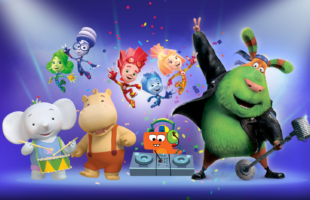Australia’s highest rating drama for 2009 has been the second series of Nine Network’s Underbelly, based on real life crime sprees and drug trafficking in Sydney and Melbourne. The Screentime-produced drama shot out of the gate with a launch audience peak of 2.8 million before settling into regular viewers around the two million mark. Knife-wielding excitement of a different kind came with Network Ten’s retooling of a very successful BBC format. MasterChef Australia turned out to be the single biggest show of 2008 with the two-hour finale hitting an average audience of 3.7 million viewers, with a peak in excess of four million. MasterChef has single-handedly boosted Ten’s ratings share and given a lift to its ad revenues as well as generating watercooler buzz unheard of since the early years of the Idol and Big Brother franchises. Both shows will return to Australian screen as soon as the networks can manage. Underbelly with a third and final series Underbelly: The Golden Mile, focussing on Sydney’s colourful Kings Cross area, and MasterChef in both a celebrity series later this year and a second series in 2010. But Masterchef has also made other food TV hot property. Seven Network wasted no time in getting into the mix. My Kitchen Rules will pit home cooks against each other in the same way that its predecessor, My Restaurant Rules, did with professional restaurant chefs. Meanwhile, multi-cultural broadcaster SBS, which has had a slate of quality food shows for some time, is seeing a raft of interest. “Food is very big for us at the moment,” says SBS’s Sharon Ramsay-Luck. She cites shows such as Food Safari, newcomer My Family Feast and Food Investigators as big performers. Still none of these zeitgeist shows come from Australia’s number one ratings network, Seven. At barely over halfway through the year Seven Network took the ratings crown for the third year in a row from perennial winner Nine. The year-to-date sees Seven with a total audience share of 36.2 percent, while Nine is down 2.3 percent to 33.3 percent, and Ten, has gained all of Nine’s lost eyeballs on it way to an increased share of 30.5 percent. Seven has one very solid drama in Packed to the Rafters, now in its second year it takes a weekly aud of around two million. But for Seven it is more about consistency. “Over the last three or four years we just built hit properties and that’s our sole aim and if we focus on that, everything else takes care of itself,” head of programming Tim Worner said. Worner points to new shows like World’s Strictest Parents, Air Ways as well as old solid performers like Border Security and its nightly news program Today Tonight as reasons for Seven’s ratings success. But, while Seven is a clear audience favourite in free to air, the real dark horse is pay TV. It’s one of the few businesses for which the recession has actually worked in its favour. Sure people had to stay home more, but it seems they were damned if they were going to give up their pay TV. In a year when audiences have been fickle about what they watch on free to air, Foxtel’s total subscriber base increased 5.8 percent to 1.63 million. “It’s consistent and it’s solid and it means that people are sticking with us and we intend to reward that and deliver on that commitment from them,” says program topper Ross Crowley talking about Foxtel’s strong growth. And the company’s recent yearly results reflected this success with its earnings growth slowing from 19 percent in the first half of 2008-09 to 12 percent in the second half. Revenue climbed 11 percent to A$1.84 billion, including a nine percent increase in subscription revenue to A$1.56 billion. All of this in the face of one of the most dire financial climates since the depression. And not content with going against the general business trend, Foxtel is changing how people use television, it reached full digital penetration years before the free to airs, who have required an extension on the Government’s analogue switch off date which is now in 2013. It has also seen great penetration for its iQ service, Foxtel’s branded PVR, which is now in 45 percent of subscriber’s homes. It is little wonder that pay TV has attracted the interest of Kerry Stokes, Seven’s majority shareholder and inveterate media investor, who earlier this year bought a 19.9 percent stake in Consolidated Media Holding, the company that owns a 25 percent stake in Foxtel. “We’re involved primarily in media,” said Stokes at Seven’s yearly results. “To be involved in both free to air and pay TV would be appropriate for us. They are not mutually exclusive and we are just as excited by free to air with multi channelling as we are with pay TV.” Still free-to-air and pay TV have one thing in common, they are fighting it out over an increasingly shrinking piece of the advertising pie. TV advertising in the metropolitan cities is down 12 percent in the year to June and, while it is a common scape goat, media analyst Andrew Anagnostellis from Deutsche Bank is loathe to blame the global financial crisis wholly for commercial television’s advertising woes. He points to Foxtel’s success as proof that while advertising is down in general it is free to air that is suffering the most. “What you will find at the end of this year is that pay TV will be flat-ish and free to air will be down anything from 9-10 percent,” he says. Seven Network’s recent yearly results tell the story. The leading web’s full year net profit took a 91.2 percent nosedive to A$12.5 million, from A$141.6m. Advertising was not entirely to blame but played a key role. All the networks are heavily discounting their ad rates, some by as much as 50 percent during a frenzy of discounted selling in February and March in this year in an effort to lock in advertisers. “The pricing model has taken a big hit, the big question is can they pull it back,” says Anagnostellis, about the cutthroat market of the past 12 months. He adds that the new multi-channel environment is not necessarily helping the free to air networks when it comes to attracting new advertisers or increased revenue streams. “The experience globally is that if you open up a multi channel environment you are really fragmenting your own audience and that is why the free to airs frankly opposed it for ten years,” Anagnostellis says. “They could have done this a long time ago but they didn’t want to because there is no incremental dollars in it.” Australia’s first new channels in nearly fifty years started in the past few months with Ten launching sports channel One and Nine general entertainment Go! Seven is yet to reveal its multi-channel offering. “The problem in the past is that the free to airs have been focussing all their energies on squashing competitors, rather than refreshing and innovating the product,” adds Anagnostellis. ”And now we have some innovation in multichannelling, it’s getting maybe one to two percent a night but its not a game changer.” One thing that might be a game changer however, after years of baseless threats, is the internet, with increased bandwidth making streaming a much better quality option than in the past. Last month, Nine Network launched an online site for ‘catch-up TV or full streaming episodes of its most popular series, Seven looks set to follow soon after. Nine has just a few local skeins at present, Seven the odd episode of soap Home and Away and Ten is still using the clip highlight format to steer viewers to its main channel. But the leader in the area of catch up TV is the Australian Broadcasting Corp. whose online service iView recently turned one. It has been a surprise hit with over 600,000 viewers a month, trebling since its launch in July 2008. Arul Baskaran, acting head of multi-platform production for the ABC, says he has been surprised by the success but believes it may well be the future of supplying content. Certainly if fits the national broadcasters remit of trying to get its content to as many viewers as possible using whatever medium is the most effective. But Baskaran is keen to point out that the reason that catch up TV’s time is due is not just because the technology is right, it is because of rather than just using the net as a filler networks have worked out that the rules of the game online are much the same as they are on the regular channels. “We have a solid slate of 300 hours and over 100 programs and the more content you have the more compelling a proposition it is.” Foxtel agrees that online is due more exploration but, while also wants a slice of the growing platform, it too is proceeding carefully. “There will be a careful growth in the new media offering over the course of the next 12 months,” says Crowley, noting that while catch up is a useful service it is not a dumping ground for product. “For something like Australia’s Next Top Model we know that the catch up window for that is while the series is on so it will be available for catch up for a 10-12 week period,” he added. “It doesn’t serve anybody to have this huge catalogue of product just sitting there unless you have got some really sophisticated search functionally and Australia is not there yet.” Part of the reason Australian television companies have been slow to move online is partly because of fear – for years the free to airs have see the internet as a threat to the all-important ratings figures rather than an opportunity to allow audiences to further engage with regular series – and partly because the industry has been protected for years by media laws. These prevented the entrance of new players and channels (even pay TV struggled in its early years) so the webs have been content to rest on their laurels and not explore new avenues. “What is happening is the free to airs being dragged kicking and screaming into the 21st century,” says Anagnostellis. “And all the fee to airs can come up with is another multi-channel offering. They’ve been very complacent and they are paying the price.” Many media buyers for example think that all these innovations may be great for the consumer but not so great for the companies involved in delivering free to air televison. “They are having to spend up for content but there is no new revenue coming their way,” says Anagnostellis. “Or if there is it is not going to be enough.” So for now, television audiences are being given a wide range of options, more channels, more product, more flexibility and the networks are desperately trying to find a way to make this new playing field work for both their customers and their shareholders.”
Ad – Before Content
Related Articles
ZEE5 Global announces the digital premiere of Telugu blockbuster Maa Nanna Superhero
Citadel: Honey Bunny Was Prime Video’s Most Watched Series Globally This Weekend
BBC World Service announces new six-part audio drama Purple Heart Warriors
Animotion Media Group Signs Exclusive Deal with ADA
- Banijay Rights Appoints Sarah Mottershead as VP for Middle East, Africa, Israel, Greece & Cyprus
Sarah Mottershead as VP for Middle East, Africa, Israel, Greece & Cyprus
TelevisaUnivision partners with Anima Kitchent to broadcast Cleo & Cuquin







